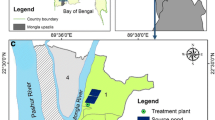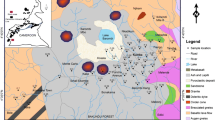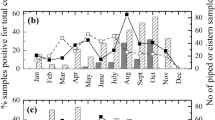Abstract
Two important environmental parameters could be identified as being the main causes of pipe borne water contamination in the City of Benin. These are the combined effects of rainfall and excessive construction work and, secondly, the lack or inadequacy of plumbing codes.
To study the combined effects of rainfall and excessive construction on the contamination of water, samples were tested for total coliform using the multiple-tube fermentation test. Sites were chosen to allow for the comparison of the coliform counts in areas of comparatively insignificant construction to areas of excessive public construction. Results show that in the areas of heavy public construction, the curves for both the rainfall and the coliform counts in the consumer lines were skewed in the same manner. The peak rainfall was in September (437.I mm) which corresponds to peak coliform number in the consumer lines for both Zone A (62 coliforms/100 ml) and Zone B (60 coliforms/100 ml) for the same month.
When compared to the area of insignificant public construction as shown in Zone C, rainfall had little or no effect on the coliform counts either at the pumping station or in the consumer line. The maximum number of coliforms recorded for the consumer line was 5/100 ml during the month of June.
Results suggest that the high counts of coliforms in the Benin City water supply could be attributed primarily to the effects of construction which resulted in pipe breakage. During heavy rainfall and flooding, water under flood pressure enters the pipes through cracks, improperly tightened joints and damaged pipes.
The improper enforcement of plumbing codes or lack of such codes was also identified as another cause of the water contamination as shown in Zone D. A study of the effects of water pipes passing through septic tank drain fields also shows that such effluents served as another source of major contamination. The highest recorded number for coliforms for the pipe-borne water just before entering the septic tank drain field was 12/100 ml and after it passed through the field the number had gone up to 60/100 ml. Artificial contamination of the septic tank effluents to try to detect leaks in the water pipes passing through the absorption field was investigated. The bacterial contaminant could be recovered in the pipe-borne water and the quantity was skewed in the same manner as total rainfall between periods of sampling.
Similar content being viewed by others
References
Caldwell, E. L. and Parr, L. W.: 1937, 1938,J. Infect. Diseases,61, 148, 180;62, 225, 272.
National Drinking Water Standards: 1973,Journal Water Pollut. Control. Fed. 45, 1637.
Obiamiwe, B. A.: 1977, Benin City, Nigeria.Annals of Trop. Med. and Parasitology 71, 35.
Standard Methods for the Examination of Water and Wastewater. 1971, American Public Health Association, 1015 18th Street, N.W. Washington, D.C. 20036.
U.S. Public Health Service: 1962, Public Health Service Drinking Water Standards, 1962. PHS Pub. No. 956, Dept. of Health, Education and Welfare, Washington, D.C.
World Health Organisation: 1963, International Standards for Drinking Water WHO. c/o American Public Health Association, 1740 Broadway, New York, N.Y. 10019 (206 pp).
Author information
Authors and Affiliations
Rights and permissions
About this article
Cite this article
J-Nkanga, E. Investigations of pipe-borne pollution in Benin City, Nigeria. Water Air Soil Pollut 13, 425–437 (1980). https://doi.org/10.1007/BF02191843
Received:
Revised:
Issue Date:
DOI: https://doi.org/10.1007/BF02191843




